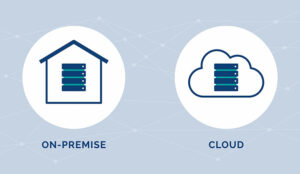Celia Cerdeira at Talkdesk reviews the basics of a cloud-based contact centre, its advantages over on-premises contact centres, and how it can help an organization handle all inbound and outbound customer communications easily and efficiently.
These days, good isn’t enough when it comes to customer service. Customers have sky-high expectations for quality customer support, and they want it fast. In fact, 49% of customers have left a brand due to poor customer service.
Cloud contact centres are well-equipped to handle the largest priorities in modern customer service. They offer all the features companies expect from contact centres, including customer relationship management (CRM) integrations, dashboard reporting, data security, and automation.
What Is a Cloud Contact Centre?
A cloud contact centre is a customer service solution that stores data in the cloud. A company can gather, store, and access all customer information and communication threads in the cloud, eliminating the need for most on-premises hardware and software.
All agents need is a computer and an internet connection – everything else will be hosted in the cloud.
Cloud contact centre software allows organizations to equip their distributed workforce and monitor agent performance, whether their team is across town, in a different region of the country, or on the opposite side of the globe.
How Does a Cloud Contact Centre Improve on the On-Premises Contact Centre Model?
While some organizations make do with on-premises contact centres, they’ve never been the perfect solution.
They’re expensive to maintain and upgrade, rely on investing in hardware and software that can quickly become outdated, and aren’t particularly flexible or suited for scaling – and their shortcomings are only more obvious as the world becomes increasingly digital.
Cloud contact centre as a service (CCaaS) are an increasingly popular solution. These platforms are hosted or built in the cloud and enable companies to pay for what they need, introducing a new level of flexibility and allowing companies to scale up or down quickly.
At the same time, cloud contact centres add new benefits on top of all the features that make on-premises contact centres the go-to solution for some organizations.
Unlike on-premises solutions, companies with cloud solutions get easy, streamlined access to the latest updates and features, including smart tools built with AI.
What Should Cloud Contact Centre Software Offer?
High-quality cloud contact centre software is the foundation for a successful cloud contact centre and, by extension, customer service that not only meets but exceeds customer expectations.
To see the best results and deliver exceptional customer experiences, a cloud contact centre solution should have flexible deployment, flexible scalability, pre-built integrations, an AI-driven self-service solution, and customer experience analytics. Here’s why.
Flexible Deployment Preserves Infrastructure During a Cloud Transition
Transitioning to a cloud model from an on-premises solution, or from a traditional call centre model, can feel like a big step.
That’s why it’s important to find a solution that minimizes friction during that transition process, with flexible deployment options that keep teams engaged.
Suppose a company opts for a cloud-based contact centre with flexible deployment options to preserve its business infrastructure during the transition.
In that case, the company can reap all the benefits of its new cloud contact centre solution without sacrificing its existing telephony infrastructure or carrier relationships. Essentially, the company will get the best of both worlds.
Scalability Leaves Room for Growth
Growing with an on-premises contact centre isn’t easy. On top of regularly upgrading hardware and software, organizations will have to purchase new assets with every expansion.
Not only will costs quickly add up, but they may also find themselves dedicating a lot of time toward planning infrastructure expansions and upgrades. Plus, there’s no easy way to undo an expansion.
On the other hand, cloud contact centres were made for flexible growth. They allow organizations to hit the ground running soon after set-up without the additional installation, provisioning, configuration, and deployment processes that on-premises centres require. Users can also easily add new agents to their existing team within minutes.
This flexible scalability is ideal for organizations large and small. Whether a company needs to scale up during peak seasons or down during slower periods, the cloud provides the agility to adjust resources quickly and cost-effectively.
It also allows for seamless updates and feature rollouts, ensuring that contact centre technology is always up-to-date without disrupting operations. This level of flexibility empowers organizations to roll with changing business needs and market conditions.
Customers with on-premises systems can seamlessly integrate flexible cloud contact centre services without sacrificing their existing setup and investments.
They can continue to use trusted business infrastructure such as their telephone system while unlocking the benefits of the cloud.
And if for security or regulatory reasons they need to keep data in house, they can opt for a hybrid cloud deployment in which the applications are run in the cloud, but the data remains on-premises. Providing both agility and adherence to industry standards.
Pre-Built Integrations and Custom Tools Allow for Tailored Solutions
Pre-built integrations can take a cloud contact centre to the next level. When organizations use a platform featuring out-of-the-box integrations, they will be able to connect their contact centre software with vital CRM software.
For example, contact centre software might integrate with Salesforce, a project management tool, or other industry applications, ensuring agents can easily access the information they need.
AI for Self-Service Ensures Faster Answers
Cloud contact centre software that features AI-driven self-service solutions makes it easy for customers to instantly get help for common questions and issues without waiting for an agent to become available, whether it’s peak operating hours or the middle of the night.
There’s no need to sacrifice quality, thanks to how advanced artificial intelligence has become. Whether an organization opts for a voice or a digital bot, they can count on their AI-driven self-service solution to quickly understand customers’ questions and respond with accurate information in a highly natural way.
Some cloud-based contact centre solutions will even automatically and seamlessly transition customers to live agents and pass along all the necessary information when they require human assistance.
What’s more, generative AI can improve cloud contact centre efficiency. Beyond enabling efficient customer self-service and freeing agents to focus on more complicated issues, generative AI can also reduce after-contact work and provide agents with concise answers, accelerating handle times.
It can even capture, analyze, and summarize customer interactions, giving valuable insights into key trends and allowing organizations to optimize their entire workforce.
This blog post has been re-published by kind permission of Talkdesk – View the Original Article
For more information about Talkdesk - visit the Talkdesk Website
Call Centre Helper is not responsible for the content of these guest blog posts. The opinions expressed in this article are those of the author, and do not necessarily reflect those of Call Centre Helper.
Author: Talkdesk
Published On: 12th Aug 2024 - Last modified: 13th Jan 2025
Read more about - Guest Blogs, Celia Cerdeira, Talkdesk






 Talkdesk is a global customer experience leader for customer-obsessed companies. Our contact center solution provides a better way for businesses and customers to engage with one another.
Talkdesk is a global customer experience leader for customer-obsessed companies. Our contact center solution provides a better way for businesses and customers to engage with one another. 
































